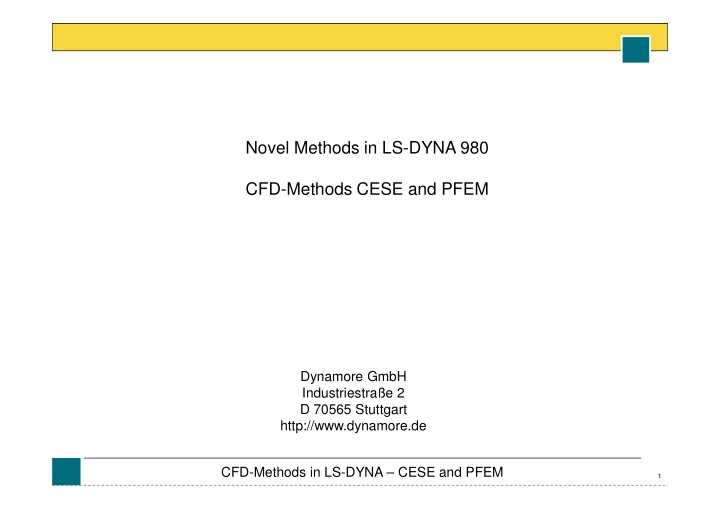

Novel Methods in LS-DYNA 980 CFD-Methods CESE and PFEM Dynamore GmbH Industriestraße 2 D 70565 Stuttgart http://www.dynamore.de CFD-Methods in LS-DYNA – CESE and PFEM 1
New CFD-capabilities in 980 Compressible / Incompressible Flows � Theoretical Basis are Navier-Stokes Equations � Different numerical approaches necessary for � Compressible flow regime (aerodynamics, Mach number >0.3) � Incompressible flow regime (Mach number <0.3) 1. Compressible Flow Solver: CESE 2. Incompressible Flow Solver: PFEM CFD-Methods in LS-DYNA – CESE and PFEM 2
New CFD-capabilities in 980 Compressible / Incompressible Flows 1. Compressible Flow Applications: � External aerodynamics - transonic or supersonic flows (flow around airfoils) � Pneumatic systems � Flow in an Airbag � � Detonation waves Detonation waves � Laminar/turbulent flows � Pressure waves are dominant effect, inviscid calculations show pressure waves (airbag, shock waves etc.) CFD-Methods in LS-DYNA – CESE and PFEM 3
New CFD-capabilities in 980 Compressible / Incompressible Flows 2. Incompressible Flow Applications: � External aerodynamics - subsonic flows (flow around cars, buildings, etc.) � Hydraulics � High viscosity flows � � Internal / External flows Internal / External flows � Due to smaller velocities, boundary layer effects have large influence (->no inviscid calculations) CFD-Methods in LS-DYNA – CESE and PFEM 4
Compressible Flow Solver Numerical Method CESE � CESE (Conservation Element & Solution Element) � Flux conservations in space and time (locally & globally) � Accuracy � 2 nd order (for flow variables & their spatial derivatives) � � Novel & simple shock-capturing strategy (transonic shock wave are Novel & simple shock-capturing strategy (transonic shock wave are dominating effect) � Both strong shocks and small disturbances can be handled very well simultaneously � Boundary conditions can be imposed easily & accurately CFD-Methods in LS-DYNA – CESE and PFEM 5
Compressible Flow Solver Numerical Method CESE CE – Conservation Element SE – Solution Element Chose integral form of conservation equations (CE): SE = FEM-solution in space and time CFD-Methods in LS-DYNA – CESE and PFEM 6
Compressible Flow Solver Numerical Method CESE Time stepping scheme: � Weighted forward/backward time difference: � Parameter automatically adjusted (smooth region/shock region) � Numerical dissipation added only where necessary (shock region) CFD-Methods in LS-DYNA – CESE and PFEM 7
Compressible Flow Solver Capabilities and application area � All speed compressible flows � Subsonic, transonic, supersonic flows � Supersonic flows with complex shock patterns � � Acoustics Acoustics � Pressure waves can accurately be resolved � Strong and small disturbances are resolved � Chemical reaction flows � Cavitating flows CFD-Methods in LS-DYNA – CESE and PFEM 8
Compressible Flow Solver Capabilities and application area � Serial & MPP mode � Flows: Inviscid & viscous flows � Meshes: Hexahedra, wedges, tetrahedra or mixture � � Boundary Conditions: Boundary Conditions: � Regular boundary conditions � solid, open, inflow, outflow, symmetric � Moving or rotating solid boundaries for viscous flows � 2D option CFD-Methods in LS-DYNA – CESE and PFEM 9
Compressible Flow Solver Capabilities and application area � Error Control and adaptive re-meshing MPP implementation. � Multifluid and Free-Surface flows. � LES and RANS turbulence models CFD-Methods in LS-DYNA – CESE and PFEM 10
Compressible Flow Solver Capabilities and application area � Examples � Transonic Flows with sharp shocks � Mesh Adaptivity improves sharp shock resolution � Multiple fluids (droplet) CFD-Methods in LS-DYNA – CESE and PFEM 11
Incompressible Flow Solver Numerical Method PFEM – Particle Finite Element Method Particle Method – “Meshless” Finite Element Method MFEM, similar to EFG 1. Discretize domains with a finite element mesh (Delaunay). Particles are mesh nodes 2. Identify external boundaries (free surfaces) 3. Compute the state variables velocities, pressure and viscous stresses 4. Move mesh nodes to a new position (Lagrangian Step) 5. Generate a new mesh if needed. The mesh regeneration process can take place (automated remeshing process) CFD-Methods in LS-DYNA – CESE and PFEM 12
Incompressible Flow Solver Numerical Method PFEM – Particle Finite Element Method Scientific background � Based on work of Onate, Idelson, Del Pin � Extended Delaunay Algorithm – fast remeshing (every time step) � MFEM approach is done for solids+fluids � � Free surface+Fluid-Structure-Interaction naturally included Free surface+Fluid-Structure-Interaction naturally included CFD-Methods in LS-DYNA – CESE and PFEM 13
Incompressible Flow Solver Capabilities and application area � Laminar+turbulent flows � Smagorinsky LES � K- ε -Turbulenz-Modell � � Conjugate heat transfer Conjugate heat transfer � Solve fluid-thermal problem coupling � Heat transfer from fluid to solid can be investigated � Multiple fluids � Boundary layer meshing for external aerodynamics CFD-Methods in LS-DYNA – CESE and PFEM 14
Fluid-Structure-Interaction Coupling algorithm � Structure and fluid solvers � Structure solver FEM (Lagrangian) � Fluid solver CESE / PFEM Displacements & velocity Fluid Structure solver solver Fluid pressure (forces) CFD-Methods in LS-DYNA – CESE and PFEM 15
Fluid-Structure-Interaction Coupling algorithm � structures can be shell and/or solid volume elements � Fluid mesh is independent of the structures � For some applications (e.g. airbag), users have the option to only calculate the inside of the bag or both sides (using the same fluid material or different ones) � Allows weak and strong FSI coupling depending upon the problem. � Coupling to explicit and implicit structural solvers CFD-Methods in LS-DYNA – CESE and PFEM 16
Fluid-Structure-Interaction Coupling example � Opening of a vessel � Heart valve � Airbag deflation CFD-Methods in LS-DYNA – CESE and PFEM 17
Thank you for your attention! Your DYNA distributor and more CFD-Methods in LS-DYNA – CESE and PFEM 18
Recommend
More recommend